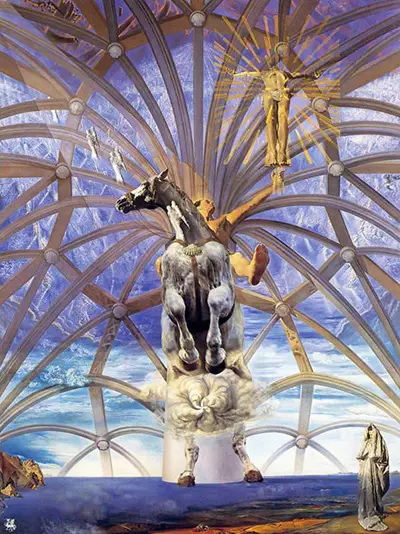Salvador Dali was one of the most important Surrealist painters of the 20th century. Born in Catalonia in Spain in 1904, he began to paint in the Surrealist style (if it can be called that) from around 1927. He was heavily influenced by the work of psychoanalyst Sigmund Freud and stressed the importance of the subconscious in creating his works.
This painting was finished in 1957 and is now on display at the Beaverbrook Art Gallery in Fredericton, New Brunswick, Canada. The canvas is 13 feet tall.
The title refers to the Christian Saint James the Great, one of the Twelve Apostles and patron Saint of Spain. The Camino del Santiago was one of the most famous pilgrimage routes of the Middle Ages, terminating at the church of Santiago di Compostella in Spain.
The painting evokes themes connected to Spain's religious and mystical past seen through the lens of Dali's Surrealist eye.
Saint James himself sits atop a massive, rearing white stallion against a backdrop of mediaeval tracery, perhaps the vault of the cathedral in Santiago de Compostella itself.
A figure of Christ on the Cross, seen from a distorted perspective as if from below, floats against the same background. Visible behind the stone tracery as if through a lattice are the mountains of the Camino del Santiago, the often perilous route that the faithful had to follow on the road to Compostella.
The steed is propelled heavenwards by a nuclear explosion in quatrefoil form emanating from a four-petalled jasmine flower. This reflects the work's fusion of the ultra-modern and scientific (nuclear physics) with the mediaeval and mystical.
The Saint on his rearing horse reaches out to touch the figure on the cross. They appear to float in the same celestial space. In the bottom right hand corner, on the shore of a deep blue Mediterranean sea, is a small veiled or robed figure that may represent the Blessed Virgin and/or an image of Gaia, Dali's wife and muse.
The harness on the horse with its scallop shell, the emblem of pilgrims to Santiago, echoes the tracery of the cathedral vault. The figure of the rearing horse, the saint and the sky/mountains behind all blend into one.
The whole image is a strange mixture of hyper-realism and mystic excess, evoking themes of national identity and religion. Dali plays with perspective and the viewer's expectations in a similar way to the technique of one of his most famous works, Christ of Saint John of the Cross, painted in 1951.


